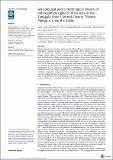Files in this item
Glaciological and climatological drivers of heterogeneous glacier mass loss in the Tanggula Shan (Central-Eastern Tibetan Plateau), since the 1960s
Item metadata
| dc.contributor.author | King, Owen | |
| dc.contributor.author | Ghuffar, Sajid | |
| dc.contributor.author | Bhattacharya, Atanu | |
| dc.contributor.author | Yao, Ruzhen | |
| dc.contributor.author | Yao, Tandong | |
| dc.contributor.author | Bolch, Tobias | |
| dc.date.accessioned | 2023-04-12T14:30:06Z | |
| dc.date.available | 2023-04-12T14:30:06Z | |
| dc.date.issued | 2023-10-01 | |
| dc.identifier | 283181228 | |
| dc.identifier | 3db319ae-80f9-47da-a76b-7c552962aa31 | |
| dc.identifier | 85174597372 | |
| dc.identifier.citation | King , O , Ghuffar , S , Bhattacharya , A , Yao , R , Yao , T & Bolch , T 2023 , ' Glaciological and climatological drivers of heterogeneous glacier mass loss in the Tanggula Shan (Central-Eastern Tibetan Plateau), since the 1960s ' , Journal of Glaciology , vol. 69 , no. 277 , pp. 1149-1166 . https://doi.org/10.1017/jog.2023.5 | en |
| dc.identifier.issn | 0022-1430 | |
| dc.identifier.other | ORCID: /0000-0002-8201-5059/work/133187283 | |
| dc.identifier.uri | https://hdl.handle.net/10023/27387 | |
| dc.description | Funding: This study was supported by the Strategic Priority Research Program of the Chinese Academy of Sciences (grant no. XDA20100300), the Swiss National Science Foundation (200021E_177652/1) within the framework of the DFG Research Unit GlobalCDA (FOR2630) and the Dragon 5 program supported by ESA and NRSCC (4000136930/22/I-NB). A. B. acknowledges research funding (grant no. CRG/2021/002450) received from Science & Engineering Research Board (SERB), Department of Science & Technology (DST), India. | en |
| dc.description.abstract | Despite their extreme elevation, glaciers on the Tibetan Plateau are losing mass in response to atmospheric warming, the pattern of which purportedly reflects regional contrasts in climate. Here we examine the evolution of glaciers along ~500 km of the Tanggula Shan, Central-Eastern Tibetan Plateau. Using remotely sensed datasets, we quantified changes in glacier mass, area and surface velocity, and compared these results to time series of meteorological observations, in order to disentangle drivers of glacier mass loss since the 1960s. Glacier mass loss has increased (from −0.21 ± 0.12 m w.e. a−1 in 1960s–2000s, to −0.52 ± 0.18 m w.e. a−1 in 2000s–2015/18) in association with pervasive positive temperature anomalies (up to 1.85°C), which are pronounced at the end of the now lengthened ablation season. However, glacier mass budget perturbations do not mirror the magnitude of temperature anomalies in sub-regions, thus additional factors have heightened glacier recession. We show how proglacial lake expansion and glacier surging have compounded glacier recession over decadal/multi-decadal time periods, and exert similar influence on glacier mass budgets as temperature changes. Our results demonstrate the importance of ice loss mechanisms not often incorporated into broad-scale glacier projections, which need to be better considered to refine future glacier runoff estimates. | |
| dc.format.extent | 18 | |
| dc.format.extent | 7333447 | |
| dc.language.iso | eng | |
| dc.relation.ispartof | Journal of Glaciology | en |
| dc.subject | Corona KH-4 | en |
| dc.subject | Glacial lake | en |
| dc.subject | Glacier mass balance | en |
| dc.subject | Surge-type glacier | en |
| dc.subject | Tibetan plateau | en |
| dc.subject | G Geography (General) | en |
| dc.subject | DAS | en |
| dc.subject | SDG 13 - Climate Action | en |
| dc.subject | MCC | en |
| dc.subject.lcc | G1 | en |
| dc.title | Glaciological and climatological drivers of heterogeneous glacier mass loss in the Tanggula Shan (Central-Eastern Tibetan Plateau), since the 1960s | en |
| dc.type | Journal article | en |
| dc.contributor.institution | University of St Andrews. Environmental Change Research Group | en |
| dc.contributor.institution | University of St Andrews. School of Geography & Sustainable Development | en |
| dc.contributor.institution | University of St Andrews. Bell-Edwards Geographic Data Institute | en |
| dc.identifier.doi | https://doi.org/10.1017/jog.2023.5 | |
| dc.description.status | Peer reviewed | en |
This item appears in the following Collection(s)
Items in the St Andrews Research Repository are protected by copyright, with all rights reserved, unless otherwise indicated.

